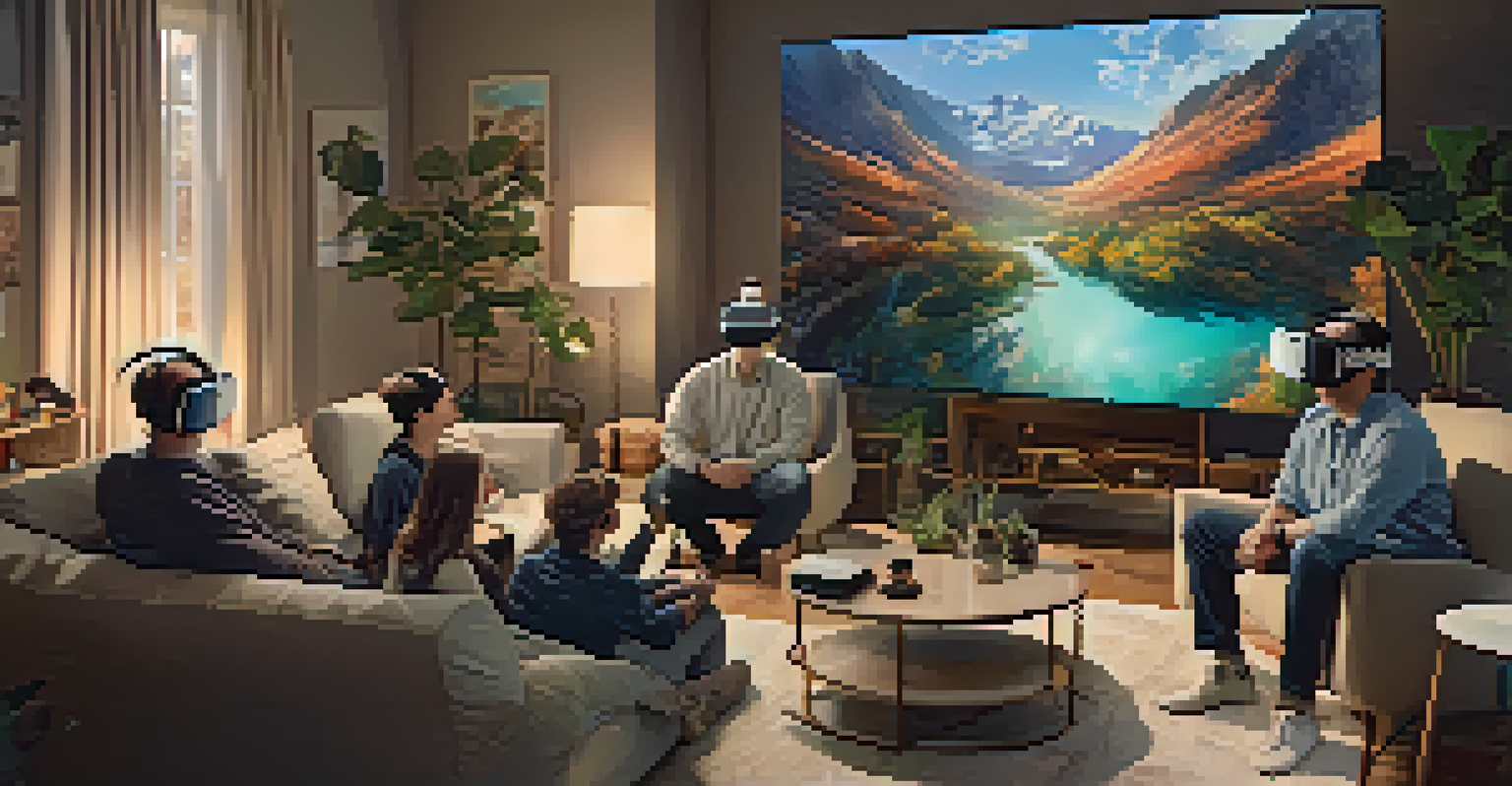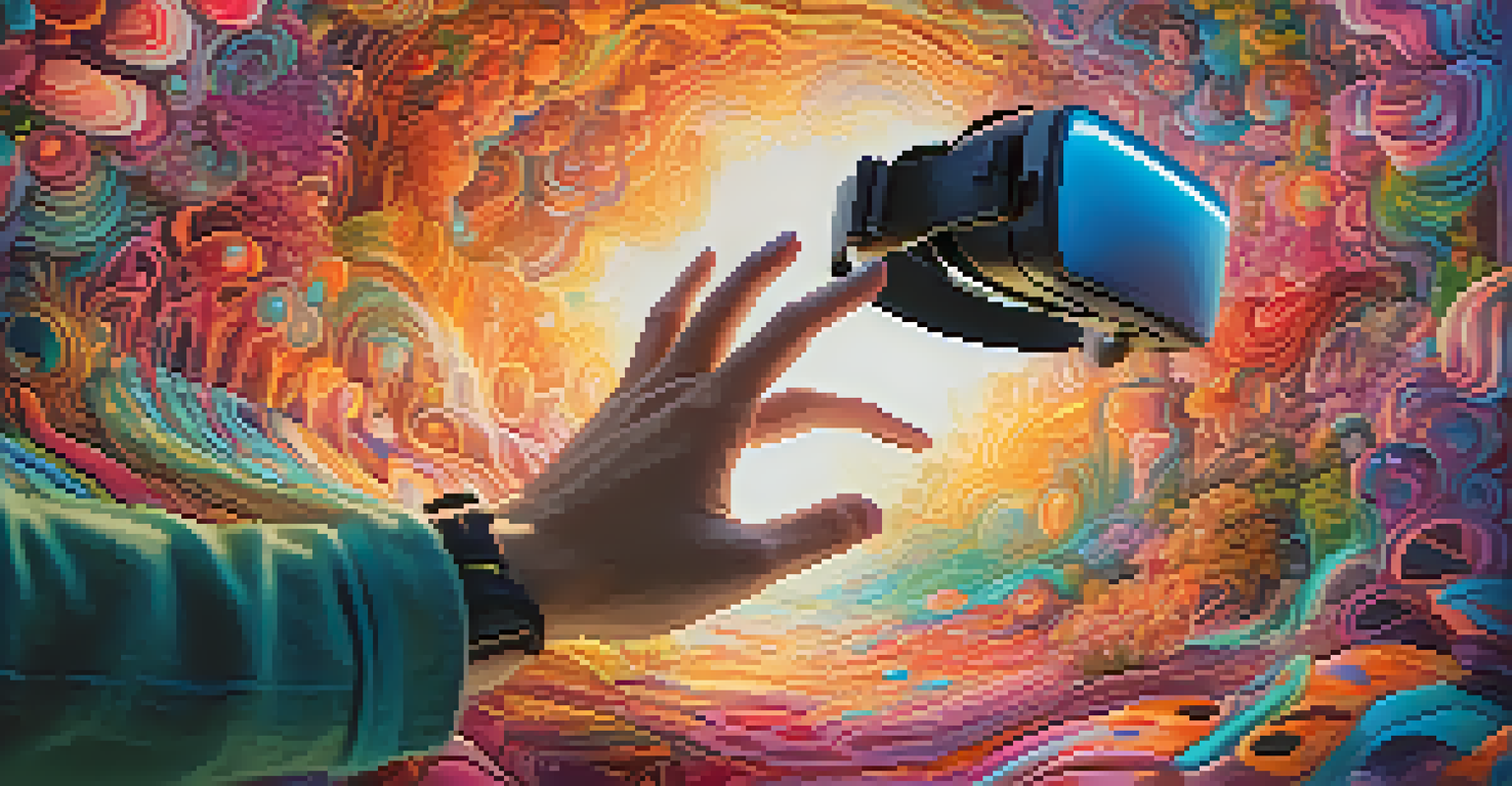Virtual Reality: The Next Frontier in Cinematic Storytelling

Understanding Virtual Reality in Film and Storytelling
Virtual reality (VR) is transforming the way we consume stories, offering an immersive experience that traditional cinema cannot match. Unlike watching a film on a flat screen, VR places the viewer inside the narrative, making them a part of the action. Imagine stepping into a world where you can look around, interact, and influence the plot—this is the magic of VR storytelling.
Virtual reality is the ultimate empathy machine.
This technology allows filmmakers to create environments that feel real, engaging our senses in ways that evoke deeper emotional responses. It's not just about watching a story unfold; it's about experiencing it from multiple perspectives. As audiences, we can feel the tension, joy, or fear as if we were living the story ourselves.
From animated adventures to documentary-style narratives, VR has the potential to explore diverse genres. As this technology evolves, so too does the language of storytelling, pushing creators to think outside the box and redefine their craft.
The Evolution of Cinematic Storytelling Techniques
Cinematic storytelling has come a long way since the days of silent films. With the advent of sound, color, and digital effects, filmmakers have continually sought new ways to captivate audiences. VR represents the next significant leap, allowing for more dynamic narratives that adapt to viewer choices.

In traditional films, storytelling is linear; the audience follows a predetermined path. In contrast, VR can create branching narratives where viewers make decisions that influence outcomes. This interactivity invites deeper engagement, transforming passive viewers into active participants in the storytelling process.
VR Transforms Storytelling Experience
Virtual reality immerses viewers in narratives, allowing them to interact and influence the story.
As filmmakers experiment with these techniques, they're crafting stories that resonate on a personal level. The ability to choose your journey not only enhances the entertainment value but also allows for unique storytelling experiences with every viewing.
Creating Immersive Worlds: The Role of Technology
The backbone of VR storytelling is advanced technology that allows creators to build immersive worlds. This includes powerful graphics engines, 3D modeling software, and interactive design tools that bring virtual environments to life. Through these technologies, filmmakers can construct detailed settings that feel both authentic and captivating.
Storytelling is the most powerful way to put ideas into the world today.
Moreover, VR experiences often incorporate sound design and haptic feedback to enhance immersion. Imagine feeling the rumble of a spaceship or the gentle breeze as you walk through a forest; these sensory elements draw the viewer deeper into the narrative. The result is a multi-layered experience that engages not just sight, but sound and touch.
As technology continues to advance, the possibilities for creating these immersive worlds are limitless. Filmmakers can experiment with new forms of storytelling, pushing the boundaries of what is possible in cinematic experiences.
Challenges Facing VR Storytelling Today
Despite its promise, VR storytelling faces several challenges that creators must navigate. One of the primary hurdles is accessibility; not everyone has access to high-end VR equipment, which can limit audience reach. As such, filmmakers need to balance the immersive quality of VR with the goal of making their stories widely available.
Additionally, developing compelling narratives in a non-linear format can be complex. Writers must think critically about structure, pacing, and viewer agency, which can complicate the creative process. Striking a balance between interactivity and story coherence is essential to retain audience engagement.
Emerging Trends in VR Storytelling
Social VR and AI integration are shaping personalized and collaborative experiences in cinematic storytelling.
Lastly, the technology itself is constantly evolving. Filmmakers must stay updated on the latest advancements while also considering user experience to ensure that the storytelling remains seamless and intuitive.
The Impact of VR on Audience Engagement
One of the most exciting aspects of VR storytelling is its potential to enhance audience engagement. By immersing viewers in a story, VR invites them to connect with characters and narratives on a deeper level. This emotional connection can lead to a more profound, memorable experience, prompting discussions and reflections long after the viewing ends.
Moreover, VR has the power to foster empathy by placing viewers in the shoes of characters facing different perspectives. This unique approach can be particularly impactful in genres like documentaries, where real-life stories and experiences are explored. The result is an opportunity for audiences to understand and empathize with diverse viewpoints.
As VR continues to gain traction, understanding its impact on engagement will be crucial for filmmakers. The ability to create meaningful connections between audiences and stories can redefine how we perceive and interact with cinema.
Future Trends in VR Cinematic Storytelling
Looking ahead, several trends are emerging in the realm of VR cinematic storytelling. One significant trend is the rise of social VR experiences, where multiple viewers can engage in a shared virtual environment. This creates opportunities for collaborative storytelling, where audiences can interact with one another and influence the narrative collectively.
Another trend is the integration of artificial intelligence (AI) to personalize storytelling experiences. AI can analyze viewer choices and preferences, tailoring narratives to fit individual tastes. This could lead to a future where each viewer has a unique experience, making storytelling even more engaging and relevant.
Challenges in VR Accessibility
Despite its potential, VR storytelling faces hurdles like equipment accessibility and narrative complexity.
Finally, as more creators embrace VR, we can expect innovative collaborations between filmmakers, game designers, and tech developers. These partnerships will likely lead to groundbreaking projects that push the boundaries of storytelling, further solidifying VR's place in the cinematic landscape.
Conclusion: Embracing the Future of Storytelling
In conclusion, virtual reality is undeniably reshaping the landscape of cinematic storytelling. With its ability to create immersive experiences and engage audiences like never before, VR opens up a world of possibilities for filmmakers. As technology advances and storytelling techniques evolve, we can anticipate exciting developments that will redefine how we experience narratives.
While challenges remain, the potential for VR to foster connection, empathy, and engagement is immense. Filmmakers who embrace this medium will not only captivate audiences but also pave the way for future innovations in storytelling.

As we stand at this exciting intersection of technology and creativity, it’s clear that the future of storytelling is here—and it’s happening in virtual reality. Don’t miss the opportunity to be part of this thrilling journey as we explore the new frontier of cinematic experiences.